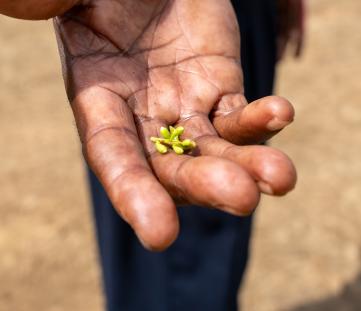ID: W35-EL7
ID: W35-EL7
Grapefruit
Citrus x paradisi
Photo
Haiti
19:35 - 18°C
My connections
My ID card
Who am I?
Date of birth
04/26/2018
Name
Grapefruit
Tree
Grapefruit
Where am I located?
Country
Haiti
Place of birth
Commune Torbeck
Coordinates
18° 18′ 55.85″ N
73° 56′ 31.37″ W
/-73.942047108711,18.315512753942,0/500x333@2x?access_token=pk.eyJ1IjoidG9tbWFzb3NwZXJvbmkiLCJhIjoiY2tnOTE3eW12MDJqazMybXNzOWV1YjloOSJ9.wtGsuDU7XIKjcv2cq8CiXw&logo=false&attribution=false)
My Timeline
The important moments in your tree's life.
Seed
It all starts with a tiny seed, nice and warm in the soil.
Nursery
Your seedling is big enough to be welcomed into one of our nurseries, along with many others.
Planted
We’re here! Your tree has reached its new home: it’s been planted by a smallholder, who’ll take care of it for years to come.
Photo
Strike a pose! Now that it’s big enough, here’s a photo of your tree!
My Gallery
Nursery

Planted
/-73.942047108711,18.315512753942,0/500x333@2x?access_token=pk.eyJ1IjoidG9tbWFzb3NwZXJvbmkiLCJhIjoiY2tnOTE3eW12MDJqazMybXNzOWV1YjloOSJ9.wtGsuDU7XIKjcv2cq8CiXw&logo=false&attribution=false)
73° 56′ 31.37″ W
Photo

Curiosity about me
The important moments in your tree's life.
Let's start with introductions
A medium-sized evergreen, the grapefruit tree is an ancient hybrid probably between the orange and the shaddock. It has by now constituted its own species for centuries and can be replanted through grafting and rootstocks.
Meaning
Unpredictability
Yellow grapefruits are generally more bitter, while pink ones are sweeter; but actually, there are many other factors that affect the taste of grapefruits. You never know exactly what to expect when you bite into one!

How much CO2 I’ll absorb
My estimated CO2 absorption capacity is based on the first 10 years of my life*
Current absorption
- 30 kg
2018
0 kg
2028
-50 kg
* The tree will continue to absorb CO2 even after the tenth year. Therefore this is a prudent estimate.
How I am useful to local communities

Consumption and sales
Its fruits, seeds and/or leaves are used as food in the farmers' families or are sold on local markets.

Medicine
Its leaves, roots, bark and/or fruits are used in traditional medicine.
My benefits
90%
Food Security
The trees will bear fruits, some that will be edible immediately and others that can become edible through processing, ensuring food resources over time.
60%
Economic development
The trees' fruits and the products derived from their transformation can be traded in local networks, offering income opportunities.
30%
CO₂ Absorption
During its life cycle, each tree will offset CO₂. The trees that you plant can offset your emissions.
20%
Environmental protection
The trees are planted in agroforestry systems that favor the virtuous interaction between the different species and their positive impact on the environment and on the land.